Impact related to Every Child Matters
Being Healthy
: Enjoying good physical and mental health and living a healthy lifestyle
NB: Click on the images
to see larger versions
Examples of how symbol supported materials have helped pupils.
Improving Self-confidence
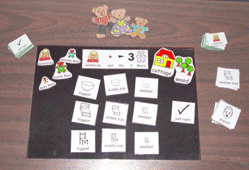 Y1
children used small story boards to re-tell a story to a group.
Y1
children used small story boards to re-tell a story to a group.
Children liked using the tabletop storyboards because the removable symbols helped them to physically sequence the story. Some children who normally find recording stories difficult had their confidence boosted because they didn't have to rely totally on adult support and were able to use the symbol/word cards to aid recording the story.
Increasing Self-esteem
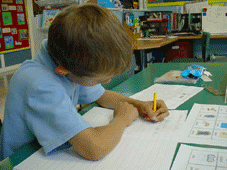 David
Y3 had poor language and communication skills and he found it difficult
to express his ideas. His writing target, to put a capital letter at the
beginning of a sentence and a full stop at the end, was also symbolised
so it could be referred to and he could see it - another visual prompt.
David
Y3 had poor language and communication skills and he found it difficult
to express his ideas. His writing target, to put a capital letter at the
beginning of a sentence and a full stop at the end, was also symbolised
so it could be referred to and he could see it - another visual prompt.
David saw himself as a 'writer' in this session which greatly boosted
his self-esteem. His behaviour in unsupported writing sessions when the
material was not accessible for him was very different. He shouted out,
distracted other pupils and was generally disruptive. - Read
the full case study
Understanding about oneself and relation to others
 Visual
timetables enable pupils to understand what is happening. Understanding
the structure of the day may diffuse tension.
Visual
timetables enable pupils to understand what is happening. Understanding
the structure of the day may diffuse tension.
A Y1 child with language and communication difficulties used to find the routine of the day difficult, especially tidying up at the end of session and moving on to the next activity. Since having the visual timetable for the whole class he can now point to the symbol and say this has finished and we're moving on to the next activity. He now seems much more settled into the routine as a result.
Managing behaviour
Target boards are useful for individuals with challenges
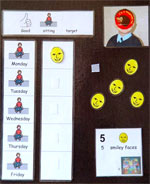 A
YR child had a target to sit still during carpet time.
A
YR child had a target to sit still during carpet time.
Having this visual prompt kept the child motivated because he was able to place his own smiley face sticker on the board when he sat appropriately. He was able to receive his reward when he had achieved five smiley face stickers. He started monitoring his own behaviour.
Symbolised Reminders of 'time out'
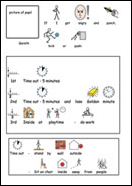 This
was made to use with a Year 5 pupil who would often become very angry
and physically violent in the playground and classroom. All staff used
these steps consistently and it shortened the time it took for the incident
to be dealt with and for the pupil to calm down. The pupil also knew exactly
'what' would happen if he behaved in such a way.
This
was made to use with a Year 5 pupil who would often become very angry
and physically violent in the playground and classroom. All staff used
these steps consistently and it shortened the time it took for the incident
to be dealt with and for the pupil to calm down. The pupil also knew exactly
'what' would happen if he behaved in such a way.
Encouraging and Rewarding Eating
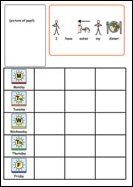 Y3
pupil was finding it difficult to eat her school dinner. She ate very
slowly due to dyspraxic problems and wanted to leave the dining hall with
her friends when they finished. Staff made a reward sheet using symbols
and a photograph so that she could have a sticker every time she finished
all her food. This really encouraged her to eat more. At the end of a
three week period she took the sheet home. Her friend was also given a
sticker as this meant she would wait as well. Lunchtime staff supervised
this and it worked well.
Y3
pupil was finding it difficult to eat her school dinner. She ate very
slowly due to dyspraxic problems and wanted to leave the dining hall with
her friends when they finished. Staff made a reward sheet using symbols
and a photograph so that she could have a sticker every time she finished
all her food. This really encouraged her to eat more. At the end of a
three week period she took the sheet home. Her friend was also given a
sticker as this meant she would wait as well. Lunchtime staff supervised
this and it worked well.
Back to top
Differentiating the Curriculum
Differentiating the curriculum using symbol supported materials can help to reduce anxiety if a pupils finds learning difficult. Having a visual clue for key vocabulary can really help pupils who have problems remembering word meanings and understanding concepts.
Whole Class use of Communicate: In Print using a whiteboard
 In
Print has been used to give Year 1 pupils key information about a lorry
and it's function. This was one of a number of screens on vehicles that
were prepared for a whole class introduction on transport. Pupils and
adults are able to add to the information or change it round by touching
the screen. The programme works very well interactively and is an exciting
way of successfully differentiating information.
In
Print has been used to give Year 1 pupils key information about a lorry
and it's function. This was one of a number of screens on vehicles that
were prepared for a whole class introduction on transport. Pupils and
adults are able to add to the information or change it round by touching
the screen. The programme works very well interactively and is an exciting
way of successfully differentiating information.
Literacy Differentiation using symbols, drawings and pictures
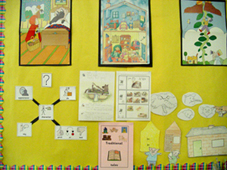 This
display shows a combination of three different methods of visual representation
to support learning. The topic is Traditional Tales which is symbolised
at the bottom using graphics and symbols.
This
display shows a combination of three different methods of visual representation
to support learning. The topic is Traditional Tales which is symbolised
at the bottom using graphics and symbols.
The display is a 'working wall' which pupils will refer to when writing their own traditional stories. The character 'web' on the left hand side gives pupils ideas about attributes their character may have - appearance, what they do, what they say and if they are good or bad.
The story 'writing' frame in the middle has ideas for the beginning, middle and end of the story. There are also pictures of familiar stories at the top and some line drawings of The Three Pigs at the bottom. The visual impact of the display encourages struggling learners and increases motivation and self esteem.
Communicate : In Print supporting learning French in Year 1
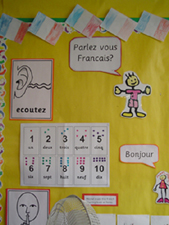
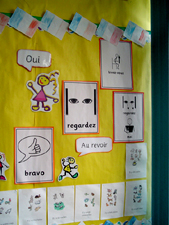
Symbol supported Materials for Roman History (Key Stage 2) and Science topics
 Information
books on the Romans with four different levels of symbolisation and a
text version allow pupils to access information at a level appropriate
to their needs. This material gives teachers instant differentiated resources
and the symbols provide visual clues for new and key vocabulary.
Information
books on the Romans with four different levels of symbolisation and a
text version allow pupils to access information at a level appropriate
to their needs. This material gives teachers instant differentiated resources
and the symbols provide visual clues for new and key vocabulary.
Key Stage 1 Science resources on Materials
 Key Stage 1 Science resources on Materials. An activity to cut and sequence
to reinforce where certain materials come from. The symbols allow pupils
who find reading and understanding text to work more independently.
Key Stage 1 Science resources on Materials. An activity to cut and sequence
to reinforce where certain materials come from. The symbols allow pupils
who find reading and understanding text to work more independently.
Year 3 Science - Magnets and Springs.
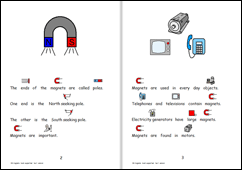 An
information book with symbols supporting key words. Pupils gain confidence
and self esteem from having information presented in this way. They are
also able to link the symbol with the word meaning and this helps with
retention of the information.
An
information book with symbols supporting key words. Pupils gain confidence
and self esteem from having information presented in this way. They are
also able to link the symbol with the word meaning and this helps with
retention of the information.
Social Group -expressing feelings, and being able to recognise stress
Social Groups improve independence and confidence enabling pupils to feel positive about themselves.
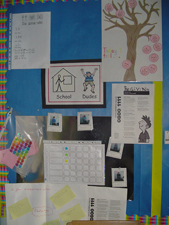
 A
Year 5 Social Group called the School Dudes used symbol support for the
group rules. This gave an easily accessible reminder during the sessions
that could be referred to. The rules encouraged listening to others, being
kind, good sitting and looking at the speaker. The group was also encouraged
to talk about how they were feeling. The photo on the right shows how
symbols can be used to help express feelings. Pupils can point to the
symbol which best matches their mood if they are unable to express the
feeling verbally.
A
Year 5 Social Group called the School Dudes used symbol support for the
group rules. This gave an easily accessible reminder during the sessions
that could be referred to. The rules encouraged listening to others, being
kind, good sitting and looking at the speaker. The group was also encouraged
to talk about how they were feeling. The photo on the right shows how
symbols can be used to help express feelings. Pupils can point to the
symbol which best matches their mood if they are unable to express the
feeling verbally.
Encouraging pupils to express feelings using the symbols as prompts.
